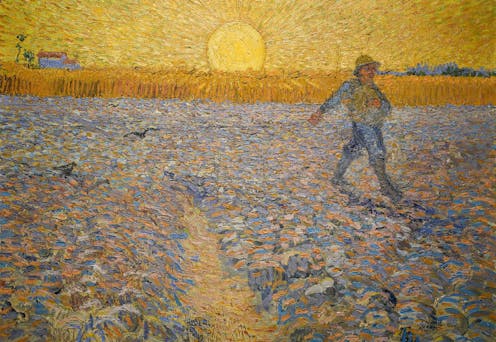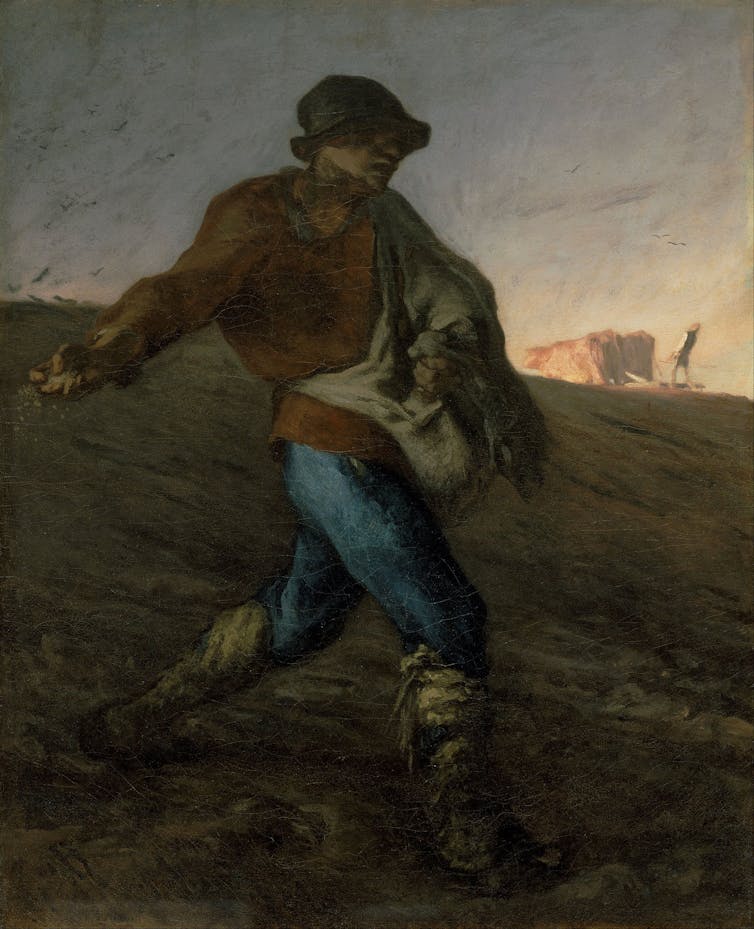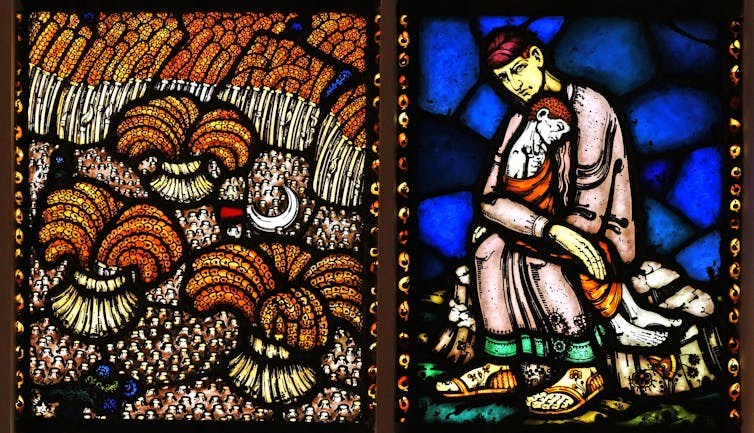What a sunny van Gogh painting of ‘The Sower’ tells us about Pope Leo’s message of hope
Van Gogh’s painting was inspired by French artist Jean-Francois Millet’s 1860 painting. But he transformed Millet’s composition into an image of hope.

In his first general audience in Rome, Pope Leo XIV referred to Vincent van Gogh’s painting “Sower at Sunset” and called it a symbol of hope. A brilliant setting sun illuminates a field as a farmer walks toward the right, sowing seeds.
Leo referred to Christ’s Parable of the Sower, a story in the Gospel that speaks to the need to do good works. “Every word of the Gospel is like a seed sown in the soil of our lives,” he said, and highlighted that the soil is not only our heart, “but also the world, the community, the church.”
He noted that “behind the sower, van Gogh painted the grain already ripe,” and Leo called it an image of hope which shows that somehow the seed has borne fruit.
Van Gogh painted “Sower at Sunset” in 1888, when he was living in Arles in southern France. At the time, he was creating art alongside his friend Paul Gauguin and feeling very happy about the future. The painting reflects his optimism.
Van Gogh’s inspiration
In November 1888, van Gogh wrote to his brother Theo, in whom he frequently confided, about “Sower at Sunset.” He described its beautiful colors: “Immense lemon-yellow disc for the sun. Green-yellow sky with pink clouds. The field is violet, the sower and the tree Prussian Blue.”

Van Gogh’s painting was inspired by French artist Jean-Francois Millet’s 1860 painting, “The Sower.” But he transformed Millet’s composition, in which a dark, isolated figure dominates, and deliberately set the sower in the midst of a landscape transformed by the sun.
Other artists, including the Norwegian Emanuel Vigeland, explicitly depicted the Parable of the Sower. Vigeland’s series of stained-glass windows in an Oslo church explains each passage’s meaning. As the sower works, some seeds fall by the wayside and the birds immediately eat them, indicating those who hear the word of God but do not listen.

Some seeds fall on stony ground and cannot take root, a symbol of those with little tenacity. Others fall among thorns and are choked. Vigeland juxtaposed a dramatic image of a miser counting piles of money, indicating how the man’s life has become choked by desire for material gain.
The final passage of the parable states that some seeds fell on good ground and yielded a hundredfold. Vigeland’s depiction shows an image of an abundant harvest of grain next to a man seated on the ground and cradling a child in his lap.
What it says about Leo
Van Gogh’s painting corresponds to many of the ideas the new pope expressed in the first days of his papacy. Leo observed: “In the center of the painting is the sun, not the sower, [which reminds us that] it is God who moves history, even if he sometimes seems absent or distant. It is the sun that warms the clods of the earth and ripens the seed.”
The theme of the dignity of labor is also inherent in the image of the sower being deeply engrossed in physical labor, which relates to the pope’s choice of his name. The pope stated that he took on the name Leo XIV “mainly because Pope Leo XIII in his historic encyclical Rerum Novarum addressed the social question in the context of the first great industrial revolution.” Leo XIII was referring to the social question of economic injustice in the meager rewards for workers even as owners made great profits from the Industrial Revolution.
The pope saw Van Gogh’s image of the sower, like Vigeland’s, as a message of hope. That message, to him, fits with the theme of hope of The Jubilee Year proclaimed by Leo’s predecessor, Francis. Leo also expressed hope that humans listening to God would embrace service to others.
Virginia Raguin does not work for, consult, own shares in or receive funding from any company or organization that would benefit from this article, and has disclosed no relevant affiliations beyond their academic appointment.
Read These Next
AI-generated political videos are more about memes and money than persuading and deceiving
Don’t discount the threat of AI political videos fooling people, but for now, they’re mostly about…
Polytechnic universities focus on practical, career-oriented skills, offering an alternative to trad
Polytechnic universities try to incorporate skills-based learning into education.
The dystopian Pottersville in ‘It’s a Wonderful Life’ is starting to feel less like fiction
Frank Capra’s dark vision of corruption and greed highlights both the dangers of concentrated power…





